In this article:
Osteoporosis is a medical condition in which there is low bone mineral density leading to weak and brittle bones that are prone to fractures.
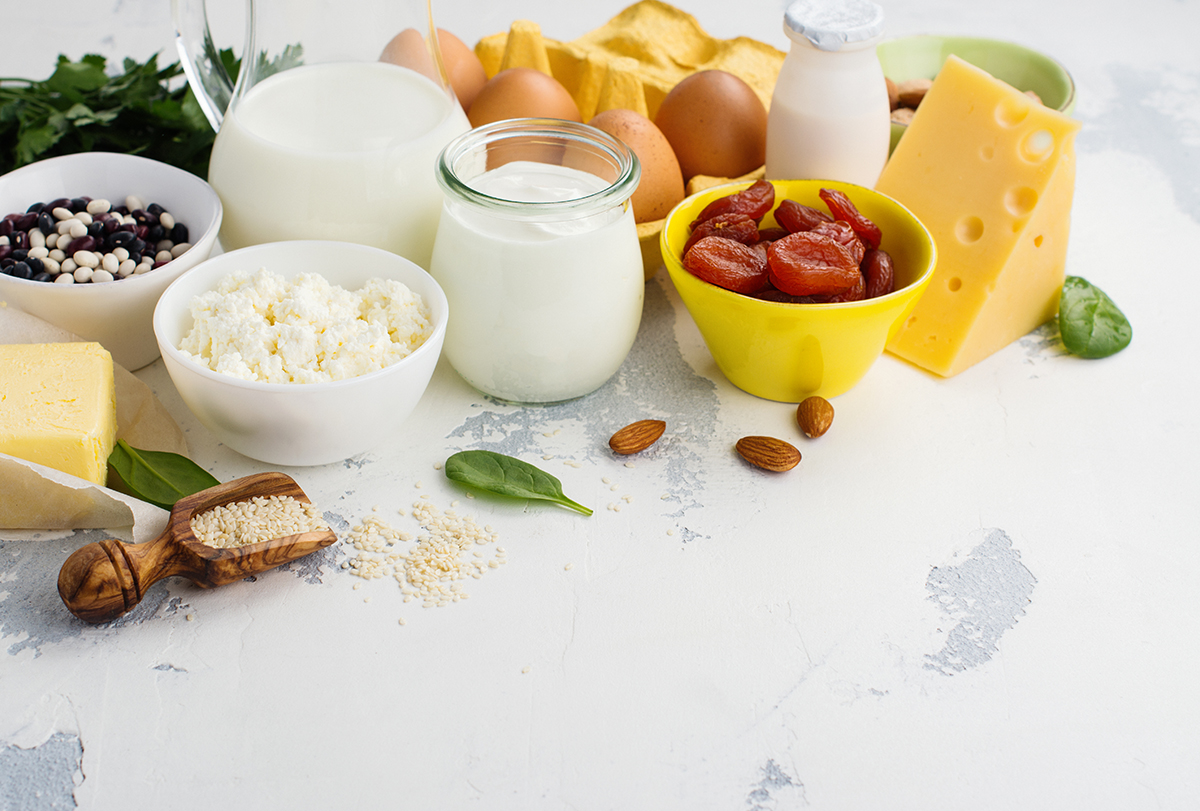
Your bones are made up of a scaffold of calcium and phosphorus, into which proteins and other micronutrients are embedded to give you the final bone tissue. (1)
Peak bone, which is the greatest amount of bone an individual can attain, occurs at the age of 30 years in most people. (2) As you age, the composition of the bone changes, and the rate of bone breakdown exceeds the rate of bone formation, leading to thinner and fragile bones.
Women are more prone to osteoporosis, especially after menopause on account of a reduction in estrogen levels.
If you are diagnosed with osteoporosis, you need to adopt a dietary regimen and avoid the risk factors to prevent the worsening of the condition.
There are also some home remedies that help in managing osteoporosis, and these are outlined in this article.
Home Remedies for Osteoporosis
The following natural remedies can help manage and relieve osteoporosis discomfort.
1. Consume foods high in calcium
To prevent fractures in old age, it is essential to achieve an optimal peak bone mass when you are younger. Nutrition plays an important role, particularly dietary intake of calcium and protein. Hence it is important to consume calcium-rich foods.
Dairy products such as milk, cheese, and yogurt are rich natural sources of calcium. Research reports conclusively state that about three servings of dairy products per day are essential to meet the required amount of calcium to achieve good bone health. (3)(4)
2. Boost vitamin D intake
Vitamin D is another essential nutrient to obtain healthy bones. It is required for bone mineralization so that calcium is deposited on the bones.
Clinical trials have reported a lowered incidence of fractures in subjects who were given calcium and vitamin D than calcium alone. (5)
You can get adequate vitamin D by maintaining a balanced diet and consuming foods rich in vitamin D such as dairy products. Vitamin D-fortified fruit juices are also available. This is one vitamin that the body produces upon exposure to sunlight. Hence, expose yourself to sunlight for at least 15 minutes daily.
Supplementation with vitamin D is only recommended in patients with a high risk of calcium and vitamin D insufficiency and not otherwise. (6)
3. Consume more fruits and vegetables
Fruits and vegetables are rich in nutrients such as the minerals magnesium and potassium, vitamins C and K, folate, and carotenoids, all of which contribute to building good, healthy, and strong bones. (7)
A diet rich in fruits and vegetables is associated with a decreased risk of hip fractures, according to a 2019 systematic review of clinical trials. (8)
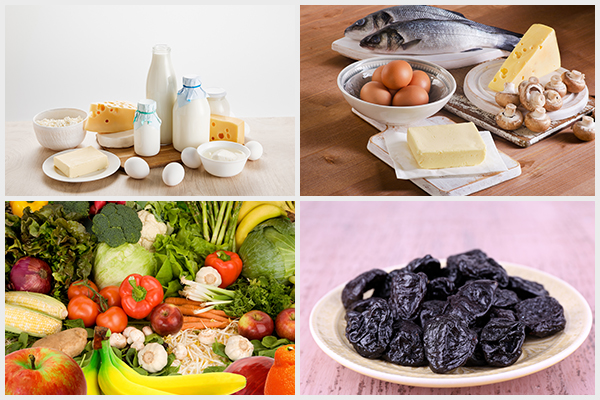
4. Consume prunes
Dried plums are an excellent source of phenolics and other nutrients that enhance bone formation and inhibit bone turnover, thus having a positive impact on bone health. (9)
Hence, snack on a handful of prunes to get your daily intake of fruits and also build healthy bones.
5. Consume apples
Apples contain phloridzin, a flavonoid that improves bone mineral density.
A review of studies conducted on ovariectomized rats (to mimic the menopausal state in women) has shown that supplementation with phloridzin (equivalent to approximately six apples/day) improved femoral bone density. (10)
Hence, consume apples to keep osteoporosis away.
6. Consume oranges
Oranges are rich in vitamin C, which improves bone formation by enhancing the function of bone-forming osteoblast cells.
In addition, vitamin C is essential for the formation of collagen, a protein necessary for binding bones and muscles together, thereby ensuring smooth movements of muscles and joints.
A 2016 clinical report published in the Journal of International Medical Research has documented the positive impact of vitamin C, β-carotene, zinc, and vegetable intake on bone health in postmenopausal Korean women. (11)
Hence, consume vitamin C-rich oranges to improve bone function and prevent osteoporosis.
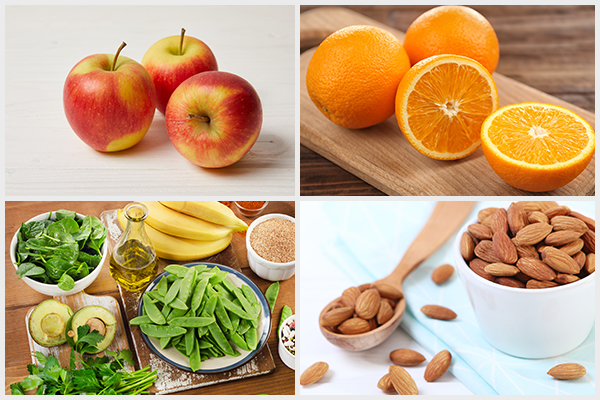
7. Ensure adequate vitamin K
Vitamin K promotes bone health by increasing bone mineral density and reducing the risk of fractures.
A 2018 study published in the Open Rheumatology Journal has established a correlation between low levels of vitamin K and osteoporosis. (12)
Hence, increasing the consumption of vitamin K can protect you from osteoporosis. You can increase your vitamin K intake by consuming foods rich in it such as fermented dairy products, broccoli, and prunes.
8. Consume almonds
Almonds are rich in bone-healthy minerals calcium, magnesium, and potassium. They are also rich in omega-3 fatty acids and alpha-linoleic acid, which protect your bones from age-related degeneration.
A 2011 in vitro study has shown that bone breakdown was inhibited by serum obtained following the consumption of an almond meal. This proves that regular almond consumption is associated with a reduced risk of developing osteoporosis. (13)
9. Take virgin coconut oil
Virgin coconut oil (VCO) is rich in antioxidants that have an inhibitory effect on osteoporosis. A 2012 study conducted on ovariectomized rats reported a beneficial effect of virgin coconut oil on bone health, which was better than calcium supplementation. (14)
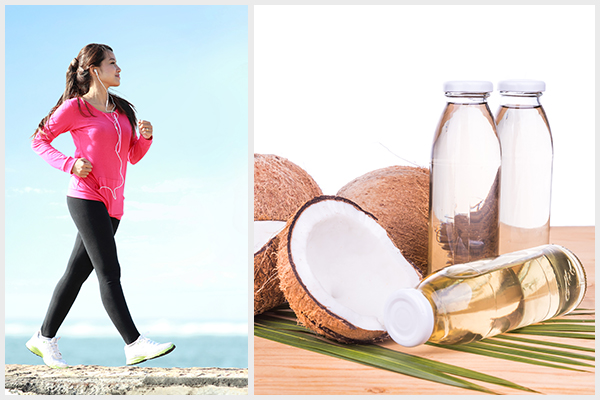
10. Exercise regularly
A sedentary lifestyle increases the risk of osteoporosis. Brisk walking, hiking, and dancing are recommended for improving bone health.
According to a 2019 study conducted on postmenopausal women and reported in Medicine, aerobic dance is recommended as a safe, effective, and efficient way of improving bone mineral density and preventing osteoporosis. (15)
Most-Asked Questions About Osteoporosis
What can cause the worsening of osteoporosis?
Medicines that affect hormonal levels such as those used to treat breast cancer and prostate cancer can cause the worsening of the symptoms of osteoporosis. Heavy smoking, heavy drinking, and a high caffeine intake can also cause worsening of osteoporosis.
Moreover, insufficient dietary intake of calcium, phosphorus, and vitamin D predisposes to bone loss. (16)
Does excessive protein intake also cause osteoporosis?
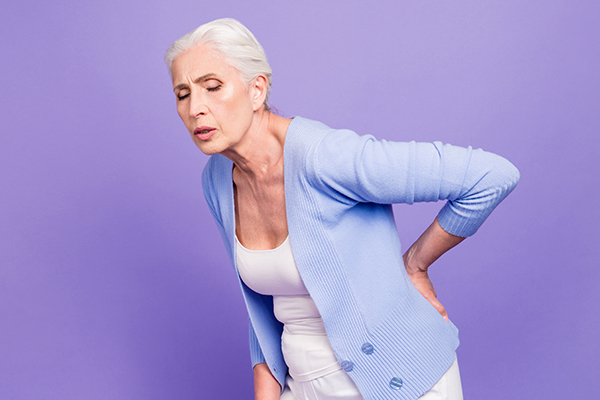
Yes, a high-protein diet has been known to cause metabolic acidosis, which is manifested by increased urinary excretion of nitrogen and calcium, (17) and chronic metabolic acidosis leads to bone mineral loss and results in lower bone mineral density. (18)
Does being too thin also predispose me to decreased bone mass?
Yes, being too thin can predispose you to decreased bone mass. (19) Even postmenopausal females with low BMI show osteopenia and are more likely to develop osteoporosis. (20)
What bones are maximally affected by osteoporosis?
The bones of the hip, wrist, and spine are the most affected by osteoporosis, and these are likely to be fractured frequently depending upon the severity of the condition.
What are the symptoms and signs of osteoporosis?
Osteoporosis may not cause any symptoms for years, but it keeps depleting your bone mass density. Over time, your bones become so thin and brittle that they fracture easily even after minimal or no obvious trauma.
As a result, patients start to experience chronic pain in the bones and muscles, particularly in weight-bearing areas like the back. (21) This pain has an acute onset and is localized to a specific region. It is often accompanied by tenderness and becomes worse by weight bearing.
The intensity of the pain may decrease after a week, but it does not go away completely for months or ever. The increased strain on the spinal muscles and ligaments, especially in the lower back, triggers a dull ache that lasts a long time.
Patients are also prone to breaking their hip or wrist bone, usually after falls.
How can women treat osteoporosis after menopause?
Menopausal women develop osteoporosis due to a decline in their estrogen levels. So, they should start taking estrogen preferably within 4–6 years of menopause (22) to reduce bone loss and the risk of fractures.
However, supplemental estrogen is also known to increase the risk of endometrial cancer and breast cancer, which is a concern.
Doctors usually recommend taking estrogen with progestin as it can help lower the risk of endometrial cancer, but it conversely makes one more prone to breast cancer, stroke, coronary artery disease, and biliary disease.
Final Word
Bones are a dynamic living tissue, and every day, your body breaks down some of this tissue and replaces some of it. Peak bone formation occurs at approximately 30 years of age.
After this, as you age, more bone tissue is broken down and less replaced, due to which the bones become weaker, leading to age-related diseases such as osteoporosis.
A foolproof way of preventing this from happening is to ensure strong bones are built in the childhood and adolescent years before 30 years of age. Building good strong bones requires a combination of good food, exercise, and maintaining a good lifestyle that includes avoiding addictive foods such as tobacco and alcohol.
- Was this article helpful?
- YES, THANKS!NOT REALLY


